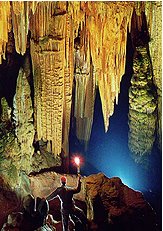The Blue Ridge Parkway Association

Right now on “The Blue Ridge Parkway Association” web site, they are featuring caverns and “Winter in the Blue Ridge.”
They have caverns listed in order from the North End of the Skyland Drive to the South End of the Blue Ridge Parkway; from Virginia, through North Carolina and Tennessee.
I have visited all of the caverns listed at some point in my life and a perennial favorite of mine is Luray Caverns, Luray, Virginia. Luray is Eastern America's largest and most popular caverns. A U.S. Natural Landmark featuring the world's only Stalacpipe Organ.
Discover Eastern America's largest and most popular caverns. A U.S. Natural Landmark noted for the profuse variety of formations and natural color. From well-lighted, paved walkways explore cathedral sized rooms with ceilings 10 stories high filled with towering stone columns and crystal-clear pools. Also, hear the haunting sounds of the world's only Stalacpipe Organ. In addition at Luray Caverns, experience the history of America in an exhibit featuring over 140 items relating to transportation including cars, carriages, coaches and costumes from 1725; along with a one acre ornamental garden creating one of the largest mazes in the Mid-Atlantic states.
For more than 125 years, Luray Caverns has been renowned as one of the world's most spectacular natural wonders. A world of magic and majesty, still as marvelously beautiful as described in the newspaper headlines over a century ago.
Since the caverns discovery in 1878 by a tinsmith and a local photographer, visitors by the millions have made Luray Caverns the most popular cave in Eastern America and an internationally acclaimed destination.
Cold air rushing out of a limestone sinkhole atop a big hill west of Luray, Virginia, blew out a candle held by Andrew Campbell, the town tinsmith. It was on the morning of August 13, 1878, when Campbell, three other men, and his 13-year old nephew Quint, were exploring for a cave. With the help of his photographer companion, Benton Stebbins, they for four hours dug away loose rock, and candle in hand, Campbell followed by Quint slid down the rope. Man and boy could scarcely believe what they saw around them, for they found themselves in the largest caverns in the East, an eerie world of stalactites and stalagmites sparkling in the light of the candle.
Alexander J. Brand, Jr., a correspondent for the New York Times, was the first travel writer to visit Luray Caverns. "It's a magnificent cave," he told townspeople. "The most beautiful I've ever seen. Trying to compare your cave to others would be like comparing New York City to the Town of Luray." Professor Jerome J. Collins, the explorer, postponed his departure on a North Pole expedition to visit the caverns. The Smithsonian Institution sent a delegation of nine scientists to examine the caverns and praised them for their stalactite and stalagmite ornamentation. The Encyclopedia Britannica devoted an unprecedented page and a half to the cave's wonders. Others considered it to be the find of the century.
 Luray Caverns features the Great Stalacpipe Organ is the world's largest musical instrument.
Luray Caverns features the Great Stalacpipe Organ is the world's largest musical instrument.Stalactites covering 3 1/2 acres of the surrounding caverns produce tones of symphonic quality when electronically tapped by rubber-tipped mallets. This most unique, one-of-a-kind instrument was invented in 1954 by Mr. Leland W. Sprinkle of Springfield, Virginia, a mathematician and electronic scientist at the Pentagon. He began his monumental 3 year project by searching the vast chambers of the caverns selecting stalactites to precisely match a musical scale. Electronic mallets were wired throughout the caverns and connected to a large four-manual console. When a key is depressed, a tone occurs as the rubber-tipped plunger strikes the stalactite tuned to concert pitch.
Today, the organ is played by activating an automated system which works in a manner similar to a child's music box. The organ is also fully capable of being played manually from the console, as Leland Sprinkle did for many years.
The National Park Service and the Department of Interior, in 1974, designated Luray Caverns a Registered Natural Landmark. The announcement proclaimed this site possesses exceptional value as an illustration of the Nation's natural heritage and contributes to a better understanding of man’s environment.
Remember - Caverns are near the same temperature year-round. Winter is an excellent time to explore them! Their gift shops sell many interesting varieties of rocks and semi-precious stones, which make excellent gifts and might just start a youngster on an interesting hobby that will enrich their life.
The Blue Ridge Parkway Association is the official promotion association for The Blue Ridge Parkway.
Technorati Tags: [Blue Ridge Parkway][Caverns][Luray Caverns][Virginia]












0 Comments:
Post a Comment
<< Home